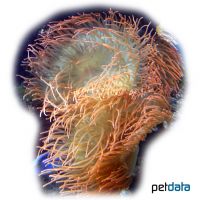Sebae Anemone (Heteractis malu)
| Sebae Anemone Heteractis malu | |
|---|---|
| Name | Sebae Anemone |
| Name Lat. | Heteractis malu |
| Family | Host Anemones |
| Family lat. | Stichodactylidae |
| Order | Sea Anemones |
| Order lat. | Actiniaria |
| Origin | Pacific |
| Diet | Autotrophic, carnivore |
| pH | 8.1-8.4 |
| Hardness | 8-10 °KH |
| Lighting | High |
| Current | Moderate |
| Behavior | Aggressive |
| Keeping | Individual |
| Care Level | Difficult |
| Life Span | N/A |
| Protection | No |
| Metric Units | |
| Size | 20 cm |
| Temperature | 22-27 °C |
| Salinity | 33-36 ‰ |
| Aquarium | 300 l |
| US Units | |
| Size | 8" |
| Temperature | 72-81 °F |
| Salinity | 1.020-1.025 sg |
| Aquarium | 80 gal |
Distribution and habitat
The distribution area of Heteractis malu is the western and central Pacific, from Hawaii over Japan to the coast of eastern Australia. They live deeply buried in shallow water, usually only their mouth disc is visible.
Maintenance
They need an aquarium with a sandy substrate at least 10 cm deep to burrow into, and they should be positioned in a very bright spot with a moderately strong, alternating current.
Only substrates rich in lime and free of heavy metals should be used as substrate. Filters, skimmers and heaters are necessary to ensure water quality, as well as pumps to simulate tides, swells and bottom currents. It is recommended that live stones be used to set up the aquarium. The bacteria living in the porous stones act as a biological filter. The lighting must correspond to the species-appropriate day-night rhythm of the animals
| Salinity: 33-36 ‰ | pH value: 8.1-8.4 |
| Carbonate hardness: 8-10 °KH | Nitrate content: 2-8 mg/l |
| calcium content: 420-450 mg/l | Nitrite content: 0.0-0.05 mg/l |
| Magnesium content: 1.250-1.350 mg/l | phosphate content: 0.01-0.1 mg/l |
Regular addition of trace elements, especially magnesium, iodine and strontium is recommended. For salinity, an average value should be aimed for, which may only vary slightly by +/- 0.5 ‰. Ammonia and ammonium must not be measurable. Special attention shall be paid to consistently good water quality and water values.
Diet
Zooxanthellae, which are unicellular symbiotic algae, live in their tissue and provide them with assimilation products of their photosynthesis (high light requirement). The zooxanthellae promote growth and provide additional food to the plankton and small particles collected from the water current. Accordingly, in addition to the food produced in the aquarium during fish feeding (mysis, krill, Artemia, etc.), commercially available supplementary food in the form of phyto- and zooplankton should be offered regularly. Regular and varied feeding promotes health and prevents deficiency symptoms.
Behaviour and compatibility
They should not be kept with fish that consider polyps as food (e.g., angelfish or butterflyfish). In nature, it is the symbiotic anemone of Amphiprion clarkii (Clark's anemonefish). In the aquarium, other anemonefishes are often accepted as well as Periclimenes shrimp. A sufficient distance must be kept to corals to avoid encrustation.
Reproduction and breeding
They are separately sexual. Their larvae are part of the plankton for several weeks until they settle in a suitable place. Reproduction by division is also possible. There are no known reports of successful breeding in the aquarium.
Important
The Amphiprion clarkii living in symbiosis with her are very helpful in the not unproblematic acclimation. Healthy animals have a closed oral disc, look "pumped up" and do not drift around.
The additional lighting with actinic light (short-wave, violet-blue light) is very beneficial for their growth (zooxanthellae)
Newly introduced animals must be acclimated slowly to the water in the aquarium. If different species are kept together, make sure that fish and invertebrates match each other in terms of water quality and temperature requirements as well as their social behavior, and that the setup meets the ecological needs of all species kept together
Further literature can be found in your pet store.
References
Text: petdata; Image: petdata
Source: BAENSCH & DEBELIUS (2006): Meerwasser Atlas Bd. 1, Mergus Verlag
